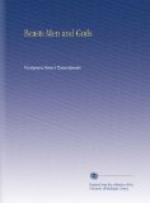CHAPTER XV
THE MARCH OF GHOSTS
In no other way can I describe the journey from the River Ero to the border of Tibet. About eleven hundred miles through the snowy steppes, over mountains and across deserts we traveled in forty-eight days. We hid from the people as we journeyed, made short stops in the most desolate places, fed for whole weeks on nothing but raw, frozen meat in order to avoid attracting attention by the smoke of fires. Whenever we needed to purchase a sheep or a steer for our supply department, we sent out only two unarmed men who represented to the natives that they were the workmen of some Russian colonists. We even feared to shoot, although we met a great herd of antelopes numbering as many as five thousand head. Behind Balir in the lands of the Lama Jassaktu Khan, who had inherited his throne as a result of the poisoning of his brother at Urga by order of the Living Buddha, we met wandering Russian Tartars who had driven their herds all the way from Altai and Abakan. They welcomed us very cordially, gave us oxen and thirty-six bricks of tea. Also they saved us from inevitable destruction, for they told us that at this season it was utterly impossible for horses to make the trip across the Gobi, where there was no grass at all. We must buy camels by exchanging for them our horses and some other of our bartering supplies. One of the Tartars the next day brought to their camp a rich Mongol with whom he drove the bargain for this trade. He gave us nineteen camels and took all our horses, one rifle, one pistol and the best Cossack saddle. He advised us by all means to visit the sacred Monastery of Narabanchi, the last Lamaite monastery on the road from Mongolia to Tibet. He told us that the Holy Hutuktu, “the Incarnate Buddha,” would be greatly offended if we did not visit the monastery and his famous “Shrine of Blessings,” where all travelers going to Tibet always offered prayers. Our Kalmuck Lamaite supported the Mongol in this. I decided to go there with the Kalmuck. The Tartars gave me some big silk hatyk as presents and loaned us four splendid horses. Although the monastery was fifty-five miles distant, by nine o’clock in the evening I entered the yurta of this holy Hutuktu.
He was a middle-aged, clean shaven, spare little man, laboring under the name of Jelyb Djamsrap Hutuktu. He received us very cordially and was greatly pleased with the presentation of the hatyk and with my knowledge of the Mongol etiquette in which my Tartar had been long and persistently instructing me. He listened to me most attentively and gave valuable advice about the road, presenting me then with a ring which has since opened for me the doors of all Lamaite monasteries. The name of this Hutuktu is highly esteemed not only in all Mongolia but in Tibet and in the Lamaite world of China. We spent the night in his splendid yurta and on the following morning visited the shrines where they were conducting very solemn services with the music of gongs, tom-toms and whistling. The Lamas with their deep voices were intoning the prayers while the lesser priests answered with their antiphonies. The sacred phrase: “Om! Mani padme Hung!” was endlessly repeated.




